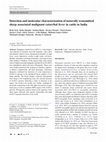Papers by Diwakar Kulkarni
The 2009 H1N1 pandemic has slowed down its spread after initial speed of transmission. The conven... more The 2009 H1N1 pandemic has slowed down its spread after initial speed of transmission. The conventional swine infl uenza H1N1 virus (SIV) in pig populations worldwide needs to be differentiated from pandemic H1N1 infl uenza virus, however it is also essential to know about the exact role of pigs in the spread and mutations taking place in pig-to-pig transmission. The present paper reviews epidemiological features of classical SIV and its differentiation with pandemic infl uenza.
The Indian veterinary journal
The Indian veterinary journal
BioMed Research International, 2014

Gene, 2015
The highly pathogenic avian influenza (HPAI) H5N1 virus, currently circulating in Asia, causes se... more The highly pathogenic avian influenza (HPAI) H5N1 virus, currently circulating in Asia, causes severe disease in domestic poultry as well as wild birds like crow. However, the molecular pathogenesis of HPAIV infection in crows and other wild birds is not well known. Thus, as a step to explore it, a comprehensive global gene expression analysis was performed on crow lungs, infected with HPAI H5N1 crow isolate (A/Crow/India/11TI11/2011) using high throughput next generation sequencing (NGS) (GS FLX Titanium XLR70). The reference genome of crow is not available, so RNA seq analysis was performed on the basis of a de novo assembled transcriptome. The RNA seq result shows, 4052 genes were expressed uniquely in noninfected, 6277 genes were expressed uniquely in HPAIV infected sample and of the 6814 genes expressed in both samples, 2279 genes were significantly differentially expressed. Our transcriptome profile data allows for the ability to understand the molecular mechanism behind the recent lethal HPAIV outbreak in crows which was, until recently, thought to cause lethal infections only in gallinaceous birds such as chickens, but not in wild birds. The pattern of differentially expressed genes suggest that this isolate of H5N1 virus evades the host innate immune response by attenuating interferon (IFN)-inducible signalling possibly by down regulating the signalling from type I IFN (IFNAR1 and IFNAR2) and type II IFN receptors, upregulation of the signalling inhibitors suppressor of cytokine signalling 1 (SOCS1) and SOCS3 and altering the expression of toll-like receptors (TLRs). This may be the reason for disease and mortality in crows.

Tropical Animal Health and Production, 2014
Malignant catarrhal fever (MCF) is a fatal herpesvirus infection of domestic and wild ruminants, ... more Malignant catarrhal fever (MCF) is a fatal herpesvirus infection of domestic and wild ruminants, with a short and dramatic clinical course characterized primarily by high fever, severe depression, swollen lymph nodes, salivation, diarrhea, dermatitis, neurological disorders, and ocular lesions often leading to blindness. In the present study, fatal clinical cases of sheep associated malignant catarrhal fever (SA-MCF) were identified in cattle in the state of Karnataka. These cases were initially presented with symptoms of diarrhea, respiratory distress, conjunctivitis, and nasal discharges. Laboratory diagnosis confirmed the detection of ovine herpesvirus-2 (OvHV-2) genome in the peripheral blood samples of two ailing animals. The blood samples collected subsequently from sheep of the neighboring areas also showed presence of OvHV-2 genome indicating a nidus of infection in the region. The positive test results were further confirmed by nucleotide sequencing of the OIE approved portion of tegument gene as well as complete ORF8 region of the OvHV-2 genome. Phylogenetic analysis based on the sequence of the latter region indicated close genetic relationship with other OvHV-2 reported elsewhere in the world.
Indian Journal of Microbiology, 2009
The 2009 H1N1 pandemic has slowed down its spread after initial speed of transmission. The conven... more The 2009 H1N1 pandemic has slowed down its spread after initial speed of transmission. The conventional swine infl uenza H1N1 virus (SIV) in pig populations worldwide needs to be differentiated from pandemic H1N1 infl uenza virus, however it is also essential to know about the exact role of pigs in the spread and mutations taking place in pig-to-pig transmission. The present paper reviews epidemiological features of classical SIV and its differentiation with pandemic infl uenza.

Uploads
Papers by Diwakar Kulkarni